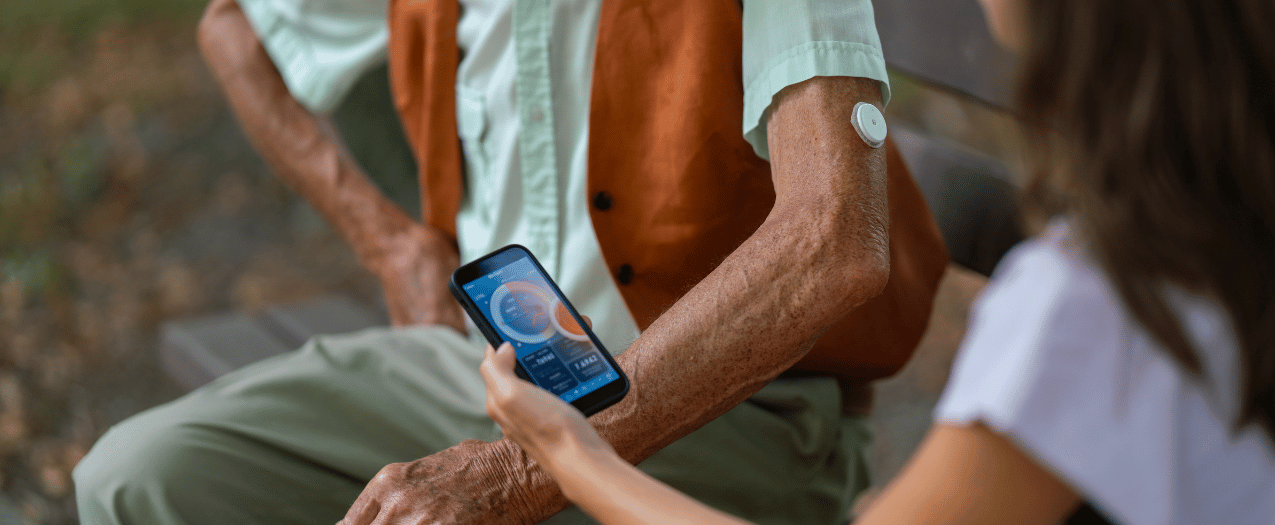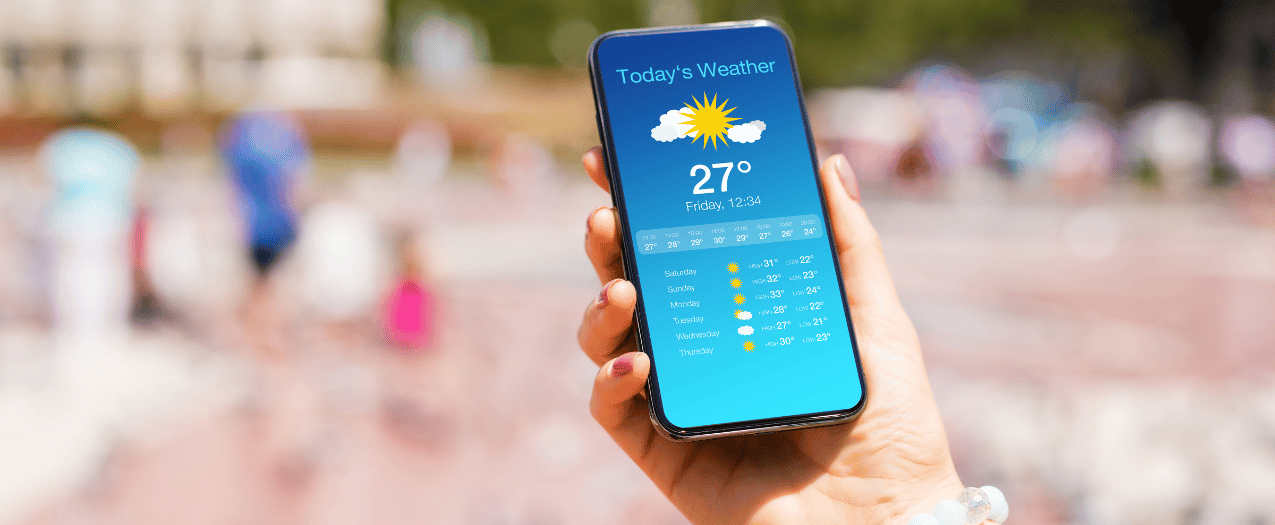
In 2024, the U.S. Food and Drug Administration (FDA) approved the first over-the-counter continuous glucose monitor (CGM). While this approval was intended for people with type 2 diabetes who don't use insulin, many people without diabetes are curious to know their numbers. Glucose readings can give some pretty unique insight into health and wellness, but should people who don’t have diabetes invest in a CGM system or stick to more traditional wellness plans? Here, we'll go over everything you need to know about the benefits of continuous glucose monitors for people with diabetes and beyond.
What Are Continuous Glucose Monitors (CGMs)?
A continuous glucose monitor (CGM) is a medical device used to track blood sugar levels in real-time throughout the day and night. Unlike traditional fingerstick tests that provide a single glucose reading, CGMs offer continuous insights, helping people make informed decisions about their health based on the effects of lifestyle interventions on their blood sugar.
How Does a CGM Work?
Continuous glucose monitors have three main components that provide real-time blood glucose data. These include the sensor, transmitter, and receiver or smartphone app.
- Sensor — A tiny, flexible filament inserted under the skin (typically on the arm or abdomen) measures glucose levels in the interstitial fluid.
- Transmitter — The sensor sends glucose readings wirelessly to a receiver, smartphone, or insulin pump.
- Receiver or App — Displays real-time glucose data, trends, and alerts for high or low blood sugar levels.
The sensor collects glucose readings every few minutes, which are then transmitted to a display device. Every blood glucose meter is different, but a CGM provides ongoing insight into diabetes care and management. You can find some of our recommendations for the best continuous glucose monitors here.
How to Use a CGM
Using a CGM is fairly straightforward, as once the sensor is in place, the device does most of the work on its own. However, different brands and models of CGMs have different sensor-related lifespans. For instance, Dexcom models have sensors that typically need to be replaced every 10 days, while some Freestyle models can last up to two weeks. The longest CGM sensor is by Eversense, which can last up to 365 days. However, this sensor needs to be implanted by a healthcare professional. Unless you want the implantable option, the general basics of using a CGM are as follows:
- Insert the Sensor — Use an applicator to place the sensor under the skin, typically on the back of the arm or abdomen.
- Attach the Transmitter — If required, attach the transmitter to the sensor to enable data transmission.
- Connect to a Device — Pair the CGM with a smartphone app, insulin pump, or separate receiver.
- Monitor Readings — Check glucose trends, receive alerts for highs and lows, and track patterns over time.
- Replace the Sensor — Sensors typically last 7–14 days before needing replacement, depending on the CGM model.
If you have any questions or concerns about your CGM and how to use it, it's best to talk to your doctor or diabetes specialist.
Benefits of Continuous Glucose Monitoring
Continuous glucose monitors can provide a tremendous number of benefits for people with type 1 diabetes, people with type 2 diabetes (especially those on insulin), pregnant women with gestational diabetes, and anyone else who needs to manage diabetes. However, the FDA's recent approval also allows more individuals access to continuous blood glucose monitors. This includes individuals who are at risk for diabetes, those who have prediabetes, pregnant women who have not yet been diagnosed with gestational diabetes, and anyone else who wants to monitor their health using this wearable device. Some of the most significant benefits of using a CGM include the following:
Understand Baseline Blood Glucose Levels
One of the most valuable benefits of a continuous glucose monitor is understanding your baseline blood glucose levels. Unlike fingerstick tests, which provide only a single snapshot of your blood sugar at one moment, CGMs track glucose levels 24/7. This continuous data stream lets you see how your glucose fluctuates throughout the day and night, providing insight into your natural blood sugar trends.
For people with diabetes, understanding these baseline levels can help fine-tune insulin dosing and meal planning. For those without diabetes, monitoring baseline glucose levels can reveal how your body responds to different foods, stress, or fasting periods.
Gain Insight into Blood Sugar Patterns
Beyond simply knowing blood sugar levels, a CGM provides detailed insight into patterns and trends over time. This is particularly helpful for managing diabetes, as it allows users to see how their glucose responds to various factors like meals, physical activity, sleep, and stress. You can make proactive adjustments to avoid high or low blood sugar episodes by analyzing these trends.
For example, noticing a pattern of high blood sugar levels in the morning could indicate the need for a medication adjustment or a change in breakfast choices. Additionally, people without diabetes can use CGMs to understand their metabolic health better and identify irregularities that could signal a risk for prediabetes.
Studies show that higher-GI foods cause spikes in insulin levels, which encourage the storage of calories as fat, while low-GI foods, high in fiber and protein, encourage food to be burned for energy with lower insulin release over time. Seeing the blood glucose spike caused by high-glycemic-index foods can also reinforce healthier food choices of lower-glycemic-index foods.
Create a More Optimized Diet
Diet plays a crucial role in blood sugar regulation, and a CGM can help you tailor your eating habits for better glucose control. A CGM allows you to see how different foods affect your blood sugar levels in real-time, allowing you to make more informed dietary choices to help with ongoing diabetes management.
With a CGM, you can see which carbohydrates cause a rapid rise in blood sugar and which have a more gradual effect. This confirmation of data is often more effective in helping individuals choose one option over the other. Since it's very personalized data, it can also help you create a diabetes-friendly diet unique to your body and needs.
Enhance Exercise Performance
CGMs can also help optimize workouts by providing real-time glucose feedback. For athletes with diabetes, monitoring blood sugar during physical activity ensures they can adjust insulin or carbohydrate intake to prevent problematic highs or lows. Even for those without diabetes, understanding how different types of exercise affect glucose levels can help fine-tune training and recovery.
For instance, some individuals may find that high-intensity workouts cause blood sugar spikes, while endurance exercises lead to gradual declines. CGM data can help fuel your body more effectively and maximize performance outcomes. A lower overall blood glucose level from routine (i.e., every other day) aerobic and resistance exercises two to three days weekly also gives reinforcement to maintain workouts.
Learn How Sleep Affects Blood Sugar Levels
The relationship between sleep and diabetes is complex, but there is a direct link between sleep duration and quality and blood sugar regulation. CGMs can provide insight into nighttime glucose patterns, revealing trends such as nocturnal hypoglycemia (low blood sugar) or dawn phenomenon (early-morning blood sugar rise). Poor sleep is also linked to insulin resistance and higher fasting blood sugar levels, so tracking overnight glucose data can help identify potential sleep-related issues.
Monitor and Control Prediabetes
Individuals who are at risk for diabetes or those who have been diagnosed with prediabetes can also benefit from monitoring their blood sugar with a CGM. Understanding blood sugar fluctuations allows you to make the necessary lifestyle changes to help reverse prediabetes and prevent type 2 diabetes from occurring. We recommend speaking with a diabetes care and education specialist to better understand how to adjust your lifestyle and diet based on CGM readings.
Should You Use a CGM if You Don't Have Diabetes?
With the release of new, over-the-counter CGMs available without a prescription, many people wonder whether getting a CGM device is worth trying. While there are benefits to understanding your blood sugar levels and incorporating that into a wellness regimen, those without any risk of diabetes likely don't need one. Yes, blood sugar information can give you some interesting data, but weight loss and metabolism control using these numbers alone isn't always an exact science. Plus, a warning for low blood sugar in people who don’t have diabetes may lead to more "justifiable" unhealthy actions—i.e., consuming fast-acting carbohydrates to try and increase the numbers. Over time, this could actually result in weight gain.
That's not to say you can't use one, but it's important to talk to your doctor to help you make that decision. If done right, using CGMs regularly can help you maintain consistency with diet and exercise changes in your lifestyle, which can have cascading benefits.
However, individuals who have any risk factors or predisposition to diabetes, those diagnosed with prediabetes, and pregnant women may find tremendous benefits in utilizing continuous glucose monitoring. This technology would help you take more preventative measures against a diabetes diagnosis, which can decrease your risk in the future. Typically, individuals in these situations can get a prescription for a CGM from their healthcare provider, which also means that it will (in most cases) be converted by insurance.
If you've been diagnosed with diabetes or pre-diabetes, many CGM devices may be covered by insurance through Byram Healthcare. For those without a formal diagnosis but still interested in tracking their glucose levels, products like the Dexcom Stelo are available for purchase through ApriaHome.



